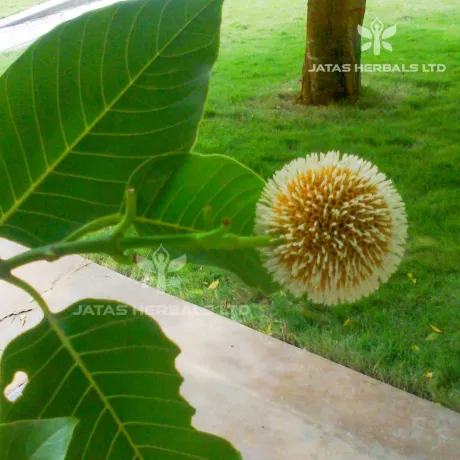It is a huge tree with orange coloured small flowers. It is found in many parts of India under cultivation. Though Kadamba is used several times by the Brihat Trayi there is some confusion in its correct identity. Sushruta indicated Nica Kadamba (Laghu Kadamba) seeds in the treatment of Svasa. Dalhana further explains in this context that Nipa=Brhat Kadamba phala and Kadamba = Laghu Kadamba phala. Bapalal and K.C. Chunekar reports various types of Kadamba (i) Raja Kadamba-A. indicus; (ii) Bhukadamba-Sphearanthus indicus; (iii) Mytragyna parviflora (iv) Adina cordifolia (v) Eleusine corocuna etc.
Botanic description – Anthocephaluscadamba is a large tree with a broad crown and straight cylindrical bole. The tree: may reach a height of 45 m with trunk diameters of 100-(160) cm. The tree sometimes has small buttresses and a broad crown. The bark is gray, smooth in young trees, rough and longitudinally fissured in old trees. Leaves glossy green, opposite, simple more or less sessile to petiolate, ovate to elliptical (15-50 x 8-25 cm). Inflorescence in clusters; terminal globose heads without bracteoles, subsessile fragrant, orange or yellow flowers; Flowers bisexual, 5-merous, calyx tube funnel-shaped, corolla gamopetalous saucer-shaped with a narrow tube, the narrow lobes imbricate in bud. Stamens 5, inserted on the corolla tube, filaments short, anthers basifixed. Ovary inferior, bi-locular, sometimes 4-locular in the upper part, style exserted and a spindle-shaped stigma. Fruitlets numerous with their upper parts containing 4 hollow or solid structures. Seed trigonal or irregularly shaped.
Major Chemical Constituents– Cadambine, pentosan, benzoic acid, n-nonacosane, chryin, gossypetin, umbelliferone, adicardin.
Part Used– Stem bark, fruit
Dosage– Dection 50-100 ml; Powder 3-5 g.
Research –
Chlorogenic acid (CGA) isolated from Anthocepha cadamba was screened for hepatoprotective activity by in vitro and in vivo assay methods using carbon tetrachloride (CCl4) as a model of liver injury. Intraperitoneal administration of CGA to mice at a dose of 100 mg/kg body weight for 8 days caused significant reversal in lipid peroxidation, enzymatic leakage, cytochrome P45O (Cyt P45O) inactivation and produced enhancement of cellular antioxidant defence in CCl4-intoxicated mice, revealing that the antioxidative action of CGA is responsible for its liver protective activity. CGA exhibited a better therapeutic protective action than silymarin (SM), in CCl4-administered mice (KAPIL A. et al., 1995).





Reviews
There are no reviews yet.